I have a data frame like this:
head(yy)
Team Date STime ETime
1 A 2012-03-06 07:03 10:13
2 A 2012-03-06 07:03 10:13
3 A 2012-03-06 07:03 10:13
4 A 2012-03-06 07:03 10:13
5 A 2012-03-06 07:03 10:13
6 A 2012-03-06 07:03 10:13
dput(yy)
dput(yy)
structure(list(Team = structure(c(1L, 1L, 1L, 1L, 1L, 1L, 1L,
1L, 1L, 1L, 1L, 1L, 1L, 1L, 1L, 1L, 1L, 1L, 1L, 1L, 1L, 1L, 1L,
1L, 1L, 1L, 1L, 1L, 1L, 1L, 1L, 1L, 1L, 1L, 1L, 1L, 1L, 1L, 1L,
1L, 1L, 1L, 1L, 1L, 1L, 1L, 1L, 1L, 1L, 1L), .Label = "A", class = "factor"),
Date = structure(c(1L, 1L, 1L, 1L, 1L, 1L, 1L, 1L, 1L, 1L,
1L, 1L, 1L, 1L, 1L, 1L, 1L, 1L, 1L, 1L, 1L, 1L, 1L, 1L, 1L,
1L, 1L, 1L, 1L, 1L, 1L, 1L, 1L, 1L, 1L, 1L, 1L, 1L, 1L, 1L,
1L, 1L, 1L, 1L, 1L, 1L, 1L, 1L, 1L, 1L), .Label = "2012-03-06", class = "factor"),
STime = structure(c(1L, 1L, 1L, 1L, 1L, 1L, 1L, 1L, 1L, 1L,
1L, 1L, 1L, 1L, 1L, 1L, 1L, 1L, 1L, 1L, 1L, 1L, 1L, 1L, 1L,
1L, 1L, 1L, 1L, 1L, 1L, 1L, 1L, 1L, 1L, 1L, 1L, 1L, 1L, 1L,
1L, 1L, 1L, 1L, 1L, 1L, 1L, 1L, 1L, 1L), .Label = "07:03", class = "factor"),
ETime = structure(c(1L, 1L, 1L, 1L, 1L, 1L, 1L, 1L, 1L, 1L,
1L, 1L, 1L, 1L, 1L, 1L, 1L, 1L, 1L, 1L, 1L, 1L, 1L, 1L, 1L,
1L, 1L, 1L, 1L, 1L, 1L, 1L, 1L, 1L, 1L, 1L, 1L, 1L, 1L, 1L,
1L, 1L, 1L, 1L, 1L, 1L, 1L, 1L, 1L, 1L), .Label = "10:13", class = "factor")), .Names = c("Team",
"Date", "STime", "ETime"), class = "data.frame", row.names = c(NA,
-50L))
I like to see the y-axis from 00:00 23:59 in 2 hours increment and be able to draw a red line on STime value.
I have somthing like this but it does not look right:
ggplot(yy, aes(Date, ETime, group="Team")) + geom_jitter(size=0.05) + facet_wrap( ~ Team) + geom_hline(yintercept=yy$Stime, colour="red", size=2)
 how would you do this in ggplot2? Can somebody give me pointers/start me in the right direction?
how would you do this in ggplot2? Can somebody give me pointers/start me in the right direction?
Regards,
